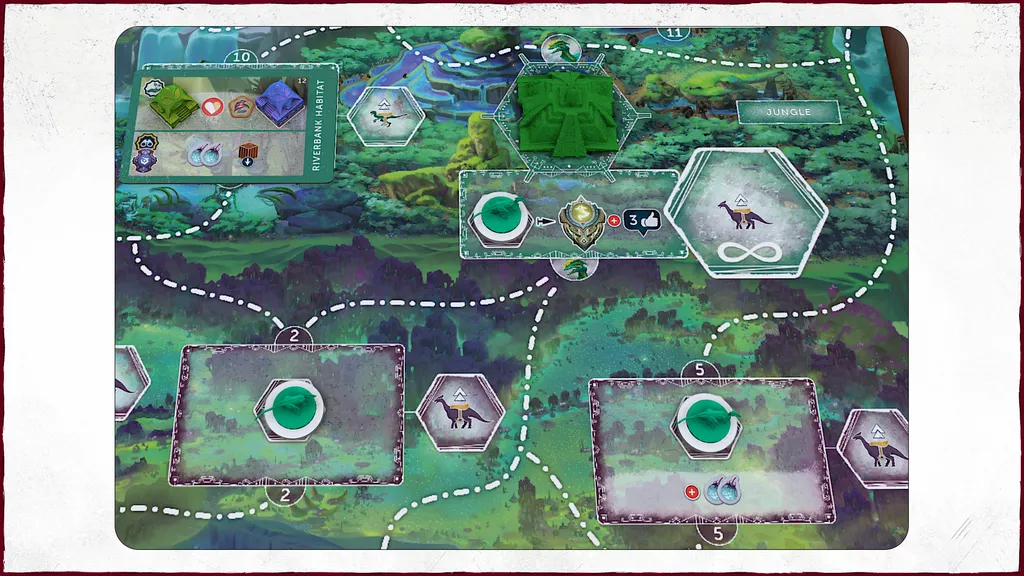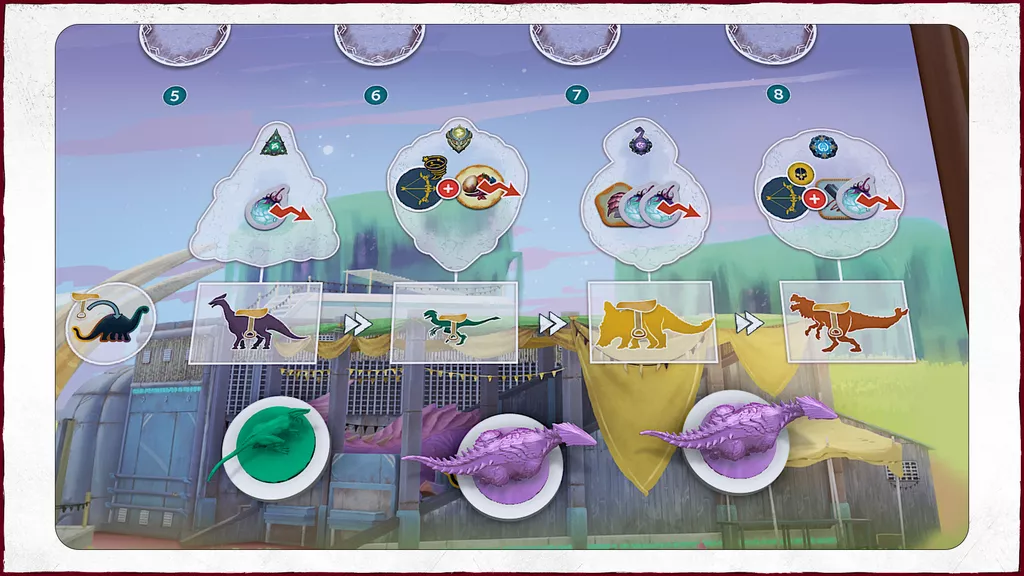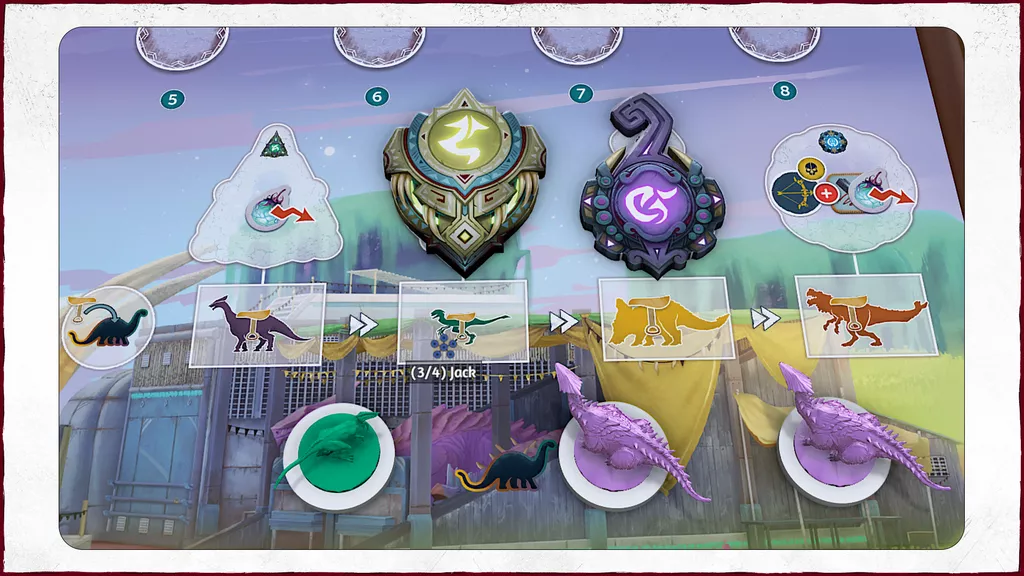Riders of the Storm
2023. October 19.
Note: any image of gameplay elements is based on our current development version, and as such is a prototype, and unlikely to be completely identical to the finished product.
I hope that since the previous post, you have been eager to hop on your dinos' backs and start exploring the island! We felt the same way during the development of the first two episodes - so let’s saddle up today and take a look at the dino rider mechanism from Episode 3!

To briefly revisit the times before the episodic concept, in the very first version of the game, dinosaurs didn't even appear on the map, and the temples didn't exist beyond conceptual thought. Once we set the goal of making the island feel like an alien paradise inhabited by various dinosaurs, where traces of a lost civilization also emerged, having dinosaurs and temples on the map became fundamental to the design.

However, the relationship between temples and dinosaurs was not straightforward. We were sure that the knowledge of taming the animals should be connected to the temples, and there wasn't any other way to tame a specific type of dinosaur initially than for a player to discover a temple beforehand. It was still a question of what privileges or bonuses the exploring player should receive. For example, should other players also have to visit the temple, or should they simply use the knowledge in the Training Zone for some extra cost?

Thanks to the branching map exploration mechanism, players unlock additional discovery opportunities as every new location leads to others. This really gives the feeling of joint exploration, and makes it easier for players to join in on the discovery of the island even later in the game. However, in the case of the Temples, this posed a bit of a challenge: we felt it was important for the player who first discovered the temple to receive some extra rewards, such as more victory points or a tamed dinosaur. But if it was too impactful, the map mechanic encouraged waiting for others to clear the way to the temple or trying to squeeze two Wilderness actions in one turn.
After much experimentation, we realized that the joy of temple discovery and the earlier free taming provided sufficient motivation, especially after artifacts were introduced into the game, as players could earn additional points by collecting them. This also improved the game's dynamics, as it was no longer "mandatory" to discover temples in a specific order; discovering a previously abandoned temple at the end of the game could still be worth it for the extra points because of the artifact collection.
To find the right balance for this, we also had to determine the cost of taming dinosaurs without taming knowledge. In the early stages, we tried two extremes: you could either tame an Ironjaw (which we called T-Rex due to the intended similarity until the announcement day  ) right away at a high cost, or you couldn't tame any dinosaurs whose temples hadn't been discovered yet by at least one of the players. There was even a point in development where we questioned whether there should be untamed dinosaurs and an Enclosure at all. Since neither extreme worked well, and we wanted to keep taming as an active mechanic, we started looking for the optimal cost for taming without the actual taming knowledge from temples. We also had to adjust the cost of the taming action and maintain thematic connections to the costs. So, the large Glowberry-consuming Shieldhead costs Glowberries, while the predators... well, they cost human lives.
) right away at a high cost, or you couldn't tame any dinosaurs whose temples hadn't been discovered yet by at least one of the players. There was even a point in development where we questioned whether there should be untamed dinosaurs and an Enclosure at all. Since neither extreme worked well, and we wanted to keep taming as an active mechanic, we started looking for the optimal cost for taming without the actual taming knowledge from temples. We also had to adjust the cost of the taming action and maintain thematic connections to the costs. So, the large Glowberry-consuming Shieldhead costs Glowberries, while the predators... well, they cost human lives.

After many iterations, we finally arrived at a mechanic that was thematic, intuitive, simple, and - after our design work ended - even more balanced, thanks to the diligent work of the development team.

Currently, the Dino Taming mechanic works as follows:
From the beginning of the game, any dinosaur can be tamed for a cost related to the type of the dinosaur, but you first need to acquire the actual dinosaur during map discoveries and confine them to the Enclosure. This means that there's no obstacle to riding an Ironjaw early on, but it won't be the first thing you do in the game.
Once the path to the temple is clear, players can send a Tamed Dino there to explore the temple, acquire the artifact and other rewards. First, the player must always battle the temple's dinosaur guardian, which is the same as the subject of the taming knowledge available here. The defeated dinosaur goes directly to the Enclosure, ready to be tamed. The artifact goes to the player board, covering the previous initial cost, meaning there will be no additional cost for taming that type of dinosaur beyond activating the taming action.

The units after taming are called Tamed Dinos, not Dino Riders. This distinction arises from the visual representation and it also serves to differentiate them from the Leaders riding dinosaurs, who are the actual Dino Riders. In the game world, Tamed Dinos are still ridden by soldiers, but you don't have to produce the soldier units separately; they are implicitly part of your Tamed Dino units.


Visualizing the tamed dinosaurs was a challenge for a long time because duplicating miniatures would have significantly increased production costs and box sizes up to a point where they were no longer feasible. We thought about colored snap-on feet for a while, but they didn't work well alongside the already colorful feet, and they didn't convey the transformation the units go through in this phase. We wanted players to feel like they had real, rideable dinosaurs waiting to explore new paths in the uncharted territories of the island.
After collaborating with Panda Manufacturing and experimenting extensively, we arrived at a flexible saddle component that we can apply to the backs of different types of dinosaurs to indicate which player they belong to. For the rather small-sized Raptors, we will make two different sizes of saddles to ensure a good fit for the figures.

For now, we only have single-color factory patterns for these components, but the results speak for themselves. Episode 3 has never been as fun and immersive as it is with this cool new solution. I hope my report has fueled your enthusiasm to become real Dino Riders yourself, if not for real, at least within the world of Perseverance.
The good news is that you only have to wait a few more weeks to see this world open up for you and get to know it up close on Gamefound. In the meantime, practice riding horses, bicycles, motorcycles, or broomsticks – whatever you have on hand!